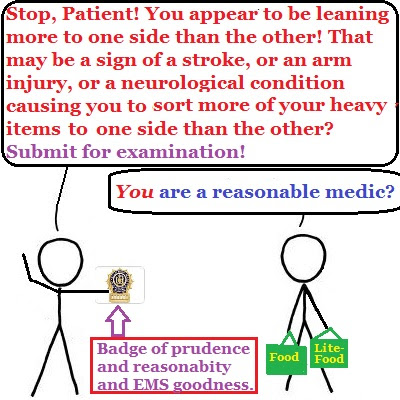What a dramatic headline!
Yanked?
They had their licenses suspended, but apparently this suspension is just a way of warning them not to do this (depending on what this is) again.
suspended because they are accused of failing to treat a patient.[1]
That does not read the same as the headline.
–
The paramedics are also accused of failing to document ambulance runs, which the EMS director says is a regular pattern of substandard, incomplete and/or lack of documentation.[1]
But we are trained to do that.
I cannot count the number of times I have been told –
If you didn’t document it, it didn’t happen.
Obviously, these medics were listening. They did not document doing anything, so how can they be accused of doing something wrong? We taught them to document this way.
True. It was not what we intended, but is ignorance an acceptable excuse for an educator?
It isn’t my fault that I don’t know what I am talking about.
It is true that this is not what is meant by if you did not document it, it did not happen, but we need to stop using bumper sticker slogans. We need to make it clear what a patient is, what a patient contact is, how patient contacts need to be documented, and how non-patient contacts need to be documented.
What is a non-patient?
Someone who does not meet criteria to be a patient.
What is a patient?
“A patient is any person who, upon contact with an EMS system, presents with a complaint, circumstance, and/or condition that might require further assessment or treatment.”[2]
Who decides what that means?
“The standard of judgment is that of a reasonable and prudent medic.”[2]
Do reasonable and prudent medics exist?
What about the definition?
A patient is any person who, . . .
This could be absolutely anyone, but there are some limitations –
upon contact with an EMS system, . . .
demonstrates at least one of the following to EMS –
presents with a complaint,
The patient is complaining of something that appears to be medical, or –
presents with a circumstance,
The circumstances suggest that there is something medical going on, even if the patient is not complaining of anything, –
and/or presents with a condition
that might require further assessment or treatment.
Depending on the person doing the interpretation, this could describe anyone. 😳
There is contact with an EMS system.
That is a person (a poor drawing of a person, but meant to represent a person).
That is a circumstance and/or a condition that might require further assessment or treatment.
This could temporarily solve some EMS budget shortfalls. 🙄
–
Footnotes:
–
[1] 2 Paramedics’ Licenses Yanked For Refusing To Treat Patient
July 18, 2012 5:34 AM
Steve Miller
WBBM CBS Chicago
Article with link to short broadcast
–
[2] “What Is A Patient?”
EMS Medical Directors of Texas
Medical Directors Committee
Page with link to document in PDF format
.



Actually, this fits in with your observations that medics downplay or disregard assessment as part of what we do. How does a paramedic know whether a person is a patient or not? By doing an assessment. Even if the “assessment” is simply asking why s/he (or someone else) called 911, if s/he has any complaints, and if s/he appears to be aware enough of their environment to make decisions, that’s still an assessment and something the crew has “done”.
Agreed that “slogan-based” education can be a problem; but the real issue is people who think that only “treatments” or “interventions” or “measurements” are things that are “done”.